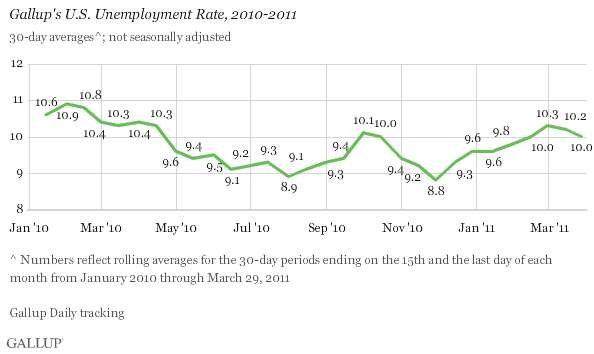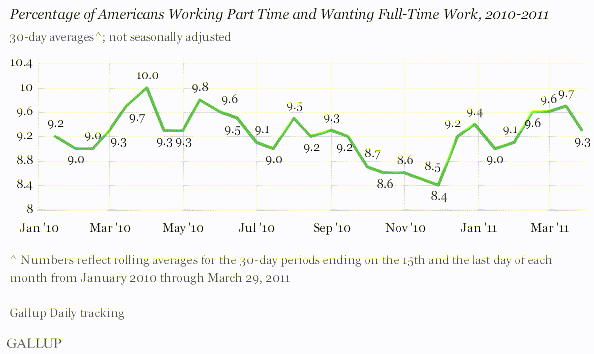-
Video: Is Washington Creating Our Jobs Crisis?
What do you think?
President Obama and the Congressional Democrats OWN the economy. They fiddled around with Climate Change, a wasteful Economic Stimulus Bill and ObamaCare while American businesses burned.
American voters will hold them accountable.
-
President 2012: Chronic Unemployment Worse Than Great Depression
This will be the number one issue in the Presidential race of 2012 – unemployment.
About 6.2 million Americans, 45.1 percent of all unemployed workers in this country, have been jobless for more than six months – a higher percentage than during the Great Depression.
The bigger the gap on someone’s resume, the more questions employers have.
“(Employers) think: ‘Oh, well, there must be something really wrong with them because they haven’t gotten a job in 6 months, a year, 2 years.’ But that’s not necessarily the case,” said Marjorie Gardner-Cruse with the Hollywood Worksource Center.
The problem of course is the economy, but some industries, especially certain manufacturing jobs, are not ever expected to come back. Experts say unemployed workers need to be prepared to change careers.
“That person has to realize that, discover what field they want to work in, become trained and find a job in that field,” said Jerry Nickelsburg, Sr., an economist at UCLA.
Here’s another problem: more than 1 million of the long-term unemployed have run out of unemployment benefits, leaving them without the money to get new training, buy new clothes, or even get to job interviews.
If the GOP nominates a half-way decent candidate, President Obama will have a hard time persuading voters that he has done a job deserving re-election.
-
Poll Watch: U.S. Unemployment Falls to 9.4% But Underemployment Increases to 19.3%

According to the latest Gallup Poll.Unemployment, as measured by Gallup without seasonal adjustment, fell to 9.4% at the end of April from 9.6% in mid-April and 9.9% at the end of March. Unemployment is now at its lowest level of 2011 and is lower than the 9.6% at the end of April last year.
So, should Americans be reassured that the economy is turning around?
Well, perhaps, since a broader unemployment measure remained high in April.
The decline in unemployment since late March was not enough to offset the increase in those working part time but wanting full-time work. As a result, the combined underemployment measure was 19.3% at the end of April — essentially the same as the 19.2% in mid-April and slightly higher than the 19.0% at the end of March. Underemployment is now higher than the 18.9% at the end of April a year ago.
Here is the graph:

While the unemployment rate has decreased a little, there are more Americans only working part-time while they desire full-time work. Some work is better than no work but the implications are clear – people will remain disgruntled – especially at the ballot box.
There has been a relatively modest decline in unemployment over the first four months of 2011, and that improvement may be at least partly the result of seasonal hiring factors. There was a similar downward trend in Gallup’s not-seasonally adjusted unemployment measure over the same four-month period in 2010. This similarity in trends also holds for Gallup’s Job Creation Index and broader underemployment over the same time frames.
These trends are consistent with the Challenger report for April that showed fewer workers being let go than in March and slightly fewer than in April a year ago, and the ADP report that found a less-than-expected 179,000 increase in private-sector hiring during April. While layoffs are down, businesses continue to hold back on their hiring in the U.S.
Although the jobs situation has been relatively flat in 2011 — not much better than in 2010 and with an increasing number of people working part time but wanting full-time work — even marginal job growth is good, given the slow growth of the first quarter of this year. At a time when the U.S. economy is facing numerous economic headwinds, including plummeting consumer confidence and soaring food and gas prices, the challenge may be to maintain this performance during the months ahead.
-
Poll Watch: U.S. Unemployment Rate is 10% in March – Down From February – But So What?

America’s unemployment rate was down in March 2011 and down from March 2010 as measured by Gallup.Unemployment, as measured by Gallup without seasonal adjustment, was 10.0% in March — down from 10.2% in mid-March and 10.3% at the end of February, but above the 9.8% at the end of January. U.S. unemployment was 10.4% at the end of March a year ago.
What about the percentage of part-time workers?

And, underemployment also declined in March.

But, what does this mean? Is America’s economy improving?
Not according to Gallup.
ADP on Wednesday reported that U.S. private-sector jobs increased by 201,000 in March — the third consecutive month at this level of job growth. At the same time, Challenger, Gray & Christmas showed a sharp decline in March U.S. layoffs compared with last year. All of this is consistent with Gallup’s Job Creation Index, which has shown slightly more jobs being created and comparatively low layoffs during the first quarter of 2011.
However, contrary to the federal government’s recent job reports, Gallup’s unemployment and underemployment measures suggest that recent job increases have not been sufficient to significantly improve the jobs situation so far in 2011. Although both of Gallup’s measures were marginally better in March, they remain higher now than they were in January.
The March improvement in the jobs situation compared with February may be partly the result of seasonal hiring patterns, with companies increasing their hiring at this time of year. However, the 2010 jobs situation didn’t show substantial improvement until the second half of April. Regardless, the decline in the underemployment rate year-over-year is consistent with a cautious hiring approach in which employers avoid layoffs while taking on more part-time workers and limiting their hiring of full-time employees.
Despite the March uptick, Gallup’s view of the U.S. jobs situation remains substantially less optimistic than the government’s recent unemployment report might suggest. Added to this, late March Gallup Daily tracking results show a continuing decline in economic optimism, a pullback in consumer spending, and a drop in Gallup’s Job Creation Index. This suggests that recent behavior on Main Street does not reflect the government’s rosier assessment. It also implies that the recent marginal improvement Gallup finds may be more temporary than one might hope.
Looks like the Obama Administration is spinning the numbers to creat some economic optimism but too many Americans remain out of work and economic activity remains stagnant at best.